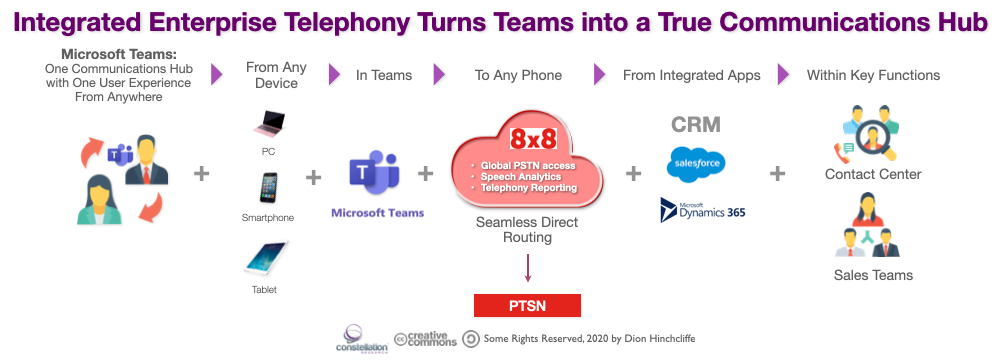With the rapid growth of Microsoft Teams over the last several years, the burgeoning team chat tool has become a critical plank in many organizations’ end-user communications strategies, especially during COVID-19. With a great many organizations around the world working from home as a result of the pandemic, the need for a single, integrated cloud-based communications system that works with their phone system is greater than ever.
A key reason for this is Microsoft’s growing positioning of Teams as its primary vehicle for team communications of each major type in the enterprise. This includes such capabilities as group collaboration, messaging, and voice/video meetings, as well as phone calls.
Many enterprises have agreed with Microsoft’s approach and now consider Teams one of the most modern and capable ways today to keep workers connected, both in the office and remotely. This approach is a vision that’s consistent with a growing industry trend that favors creating a stronger center of gravity for communications, typically around a hub or center of communications for workers.
The change dynamic in play with Teams currently is impressive: The platform recently experienced 70% rapid growth that has by now surpassed 100 million daily active users by our estimate, with over 250 million paid seats overall. This broad uptake has put Teams high on the agenda for most organizations to ensure it is operating to its full capabilities to ensure workers are productive, especially in today’s widespread remote work/work from home scenarios.
For many organizations, it thus makes compelling sense to provide a better centralized communications service like Teams that can also handle telephony as a natural and native part of the Teams experience. Having the corporate phone system integrated right within Teams, to fully realize a single unified communications application makes it simpler to provide, manage, and support one consistent set of communications services to general workers, as well as specialized business functions that have high telephony usage such as contact centers and sales teams.
What’s more, the Team growth dynamic is a potent force that IT and communications teams leaders can tap into and ride upon to quickly consolidate and improve the worker experience when it comes to team engagement and work.
Filling the Enterprise Phone Gap in Microsoft Teams
The need to take advantage of this year’s rapid global shift in digital worker behaviors with tools that better meet today’s needs is urgent, as employers struggle to streamline and make remote work more efficient. Recent data from Aternity shows the major shift is taking place at vast scale, as global Teams meetings usage alone grew a dramatic 900% February to June, 2020.
Organizations that wish to take advantage of and align with these trends by unifying their communications around teams can connect their telephony systems to Teams to provide a single point of access to all common types of collaboration.
To realize this vision, which has significant adoption, usability and productivity advantages, organizations must integrate Teams with their telephony systems in as seamless as manner as possible. This requires an enterprise-class and easy-to-administer voice solution that can keep the Microsoft Teams experience unchanged for end users, while extending them into the full realm of telephony as a first-class citizen in the collaboration experience.
Key Aspects of Integrating Enterprise Telephony with Microsoft Teams
The requirements for a robust and enterprise-class telephony solution that integrates seamlessly with Microsoft Teams are as follows:
- Public switched telephone network (PSTN) access for Microsoft Teams users with little to no alternation of the existing user experience.
- Full PSTN access for Microsoft Teams users — with unlimited calling enabled wherever its available — across geographies, with toll free and direct inward dialing (DID) numbers whenever possible.
- Straightforward and usable integrations with systems that have high telephony usage such as contact centers and CRM systems.
- Minimal to no retraining of administrators and end-users.
As an example of the trends, one leading solution for this kind of communication integration with Teams is from 8x8, a well-known software-as-a-service provider of voice, video, chat, contact center, and telephony APIs. Their new 8x8 Voice for Microsoft Teams is one of the first solutions in the industry that delivers a capability that is considered enterprise-class, as it can be provisioned, delivered, and managed as a global voice solution directly within the existing Microsoft Teams experience.
The overall value proposition for integrating Teams with telephony systems like 8x8 is considerable for communications teams:
- Eliminating using different apps for calls vs. other forms of communication
- Offering one user experience within Teams, from any device, to any phone
- Seamless integration of high value telephony solutions like contact center and CRM
- Maximizing investments in training, adoption, and productivity for Teams as well as existing telephony systems
- Delivering a streamlined and simplified remote work/work from home experience
At the end of the day, Teams can be so much more with a fully integrated telephony solution that makes an organization’s key communications methods more seamless, multimodal, and easier to use across channels.
Additional Reading
Reimagining the Post-2020 Employee Experience: A Comprehensive Blueprint
It's Time to Think About the Post-2020 Employee Experience
How Work Will Evolve in a Digital Post-Pandemic Society
Revisiting How to Cultivate Connected Organizations in an Age of Coronavirus
My 2020 Predictions for the Future of Work
Working in a coronavirus world: Strategies and tools for staying productive | ZDNet
A Checklist for a Modern Core Digital Workplace and/or Intranet
Creating the Modern Digital Workplace and Employee Experience
The Challenging State of Employee Experience and Digital Workplace Today



